The device and principle of operation of the circuit breaker
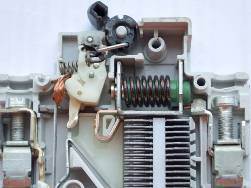 For an electrician, switching equipment is one of the main devices that you have to work with. Circuit breakers carry both switching and protective role. Not a single modern electrical panel can do without automatic machines. In this article we will look at how a circuit breaker is designed and operated.
For an electrician, switching equipment is one of the main devices that you have to work with. Circuit breakers carry both switching and protective role. Not a single modern electrical panel can do without automatic machines. In this article we will look at how a circuit breaker is designed and operated.
A circuit breaker is a switching device designed to protect cables from critical currents. This is necessary in order to avoid damage to the conductive conductors of wires and cables in case of interphase faults and earth faults. The main task of the circuit breaker is to protect the cable line from the effects of short circuit currents. The main characteristics of circuit breakers are: rated current (insert a series of currents), switching voltage, time current characteristic ...
Additional devices for circuit breakers
 In order to better and more accurately automate current protection, as well as to monitor the state of current protection of electrical equipment, in addition to circuit breakers, additional devices to them are useful. As such devices, block contacts, undervoltage releases and independent releases are used.
In order to better and more accurately automate current protection, as well as to monitor the state of current protection of electrical equipment, in addition to circuit breakers, additional devices to them are useful. As such devices, block contacts, undervoltage releases and independent releases are used.
These devices are produced today by many manufacturers of circuit breakers, which allows, in principle, to immediately get an automatic machine with advanced functionality, you just have to attach an auxiliary module to it. A contact block is a separate modular block, inside of which there is one or several contacts controlled mechanically from a circuit breaker installed in the vicinity. The contacts inside the block can be closing and / or opening. Typically, these modules are designed for switching AC up to 6 amperes ...
Main characteristics of RCD and difavtomatov
 To begin with, we will understand the differences between RCDs from the difavtomat, because outwardly they are very similar, although they differ in their functions. RCD - residual current device. It opens the circuit into which it is connected when a leakage current to the earth occurs, that is, at the moment when a differential current of a certain value begins to be present in the network, caused for example by damage to the wiring insulation or the contact of a living being with a current-carrying structure.
To begin with, we will understand the differences between RCDs from the difavtomat, because outwardly they are very similar, although they differ in their functions. RCD - residual current device. It opens the circuit into which it is connected when a leakage current to the earth occurs, that is, at the moment when a differential current of a certain value begins to be present in the network, caused for example by damage to the wiring insulation or the contact of a living being with a current-carrying structure.
The bottom line is that a person can get an electric shock from the leakage current if he accidentally comes into contact with damaged equipment. In addition, the leakage current contributes to overheating of the wiring, which can lead to a fire. For this reason, RCDs are used to protect wiring and people in the event of a leakage current, measured in milliamps. A differential circuit breaker, unlike an RCD, combines the functions of an RCD and a circuit breaker ...
Thermal circuit breaker release
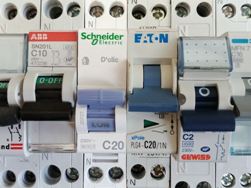 Part of the design of the circuit breaker (automatic machine) is a thermal release. The fact is that inside the circuit breaker two ways of protection against current overload are implemented right away: an electromagnetic release, opening the circuit when the rated current is exceeded several times (with a short circuit), and a thermal release, which operates at lower overload currents, but having, however, less speed than its electromagnetic ally. Of course, when the current passes through the wiring a little more than its rated current, the wiring does not burn out, so the speed of the thermal release is usually enough.
Part of the design of the circuit breaker (automatic machine) is a thermal release. The fact is that inside the circuit breaker two ways of protection against current overload are implemented right away: an electromagnetic release, opening the circuit when the rated current is exceeded several times (with a short circuit), and a thermal release, which operates at lower overload currents, but having, however, less speed than its electromagnetic ally. Of course, when the current passes through the wiring a little more than its rated current, the wiring does not burn out, so the speed of the thermal release is usually enough.
The thermal release is based on a bimetallic plate, which heats up from the current passing through it, and gradually bends if the current becomes higher and higher relative to the rating for this machine (typical, which is indicated in the marking), which ultimately leads to opening. ..
How to choose the right machine for replacing the old one in the electrical panel
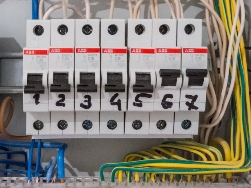 Nothing lasts forever in this world, and circuit breakers that operate in home electrical panels sooner or later fail. Problems with power supply begin, they constantly knock out or do not work at all. In this article I will tell you how to choose the right machine for replacing the old one in the electrical panel. To prevent the statements of "experts" about the style of presentation in the article I note in advance that it is aimed at a home master who wanted to re-energize the electrical panel.
Nothing lasts forever in this world, and circuit breakers that operate in home electrical panels sooner or later fail. Problems with power supply begin, they constantly knock out or do not work at all. In this article I will tell you how to choose the right machine for replacing the old one in the electrical panel. To prevent the statements of "experts" about the style of presentation in the article I note in advance that it is aimed at a home master who wanted to re-energize the electrical panel.
To begin, consider how to determine the health of the machine and the reasons for which malfunctions occur. There are 5 main problems with circuit breakers in switchboards, if we consider them at the household level and in simple language, of course. False alarms and trips at the same load. The check box of the machine does not cock when trying to turn on, jammed, or returns to the disabled state. The switch case has become charred, blackened or led ...
What are overvoltage and undervoltage releases and how are they used?
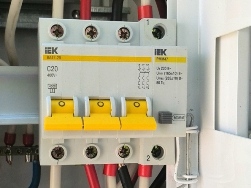 Undervoltage and overvoltage releases are one of the types of additional devices for circuit breakers. They are designed to disconnect the load in the event of a voltage deviation from the nominal 220V. In this article I will talk about the method and circuit of connecting these devices, their advantages and disadvantages.
Undervoltage and overvoltage releases are one of the types of additional devices for circuit breakers. They are designed to disconnect the load in the event of a voltage deviation from the nominal 220V. In this article I will talk about the method and circuit of connecting these devices, their advantages and disadvantages.
The undervoltage and overvoltage release is one of the devices designed to control a circuit breaker. Almost every modern modular machine can connect additional devices. To do this, there is a plug on the side of the machine, unscrewing which you will see a lever for connecting such devices to the mechanical part of the power contact drive. If you press this lever with the cocked flag of the machine (ON), it will turn off. Additional devices such as this trip units and various devices ...
How to protect wiring from overload and short circuit
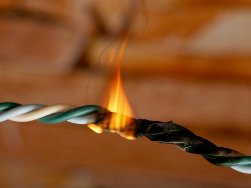 The main task of an electrician is to make wiring reliable and safe. Accidents may result in fire or electric shock. Accidents occur due to increased current and short circuits. As a result, too much current flows through the conductors, they heat up and insulation melts on them, sparking or an arc occurs. In this article I will talk about how to protect wiring from overload and short circuit.
The main task of an electrician is to make wiring reliable and safe. Accidents may result in fire or electric shock. Accidents occur due to increased current and short circuits. As a result, too much current flows through the conductors, they heat up and insulation melts on them, sparking or an arc occurs. In this article I will talk about how to protect wiring from overload and short circuit.
To understand the danger of high current flowing through wires, one needs to recall two important laws of physics from the course “electricity and magnetism”. The first is Ohm's law: The current in the circuit is directly proportional to voltage and inversely proportional to resistance. This means that if the circuit has low resistance, the current will be large, and if large, then small, and also with increasing voltage, the current increases with it. This seems obvious, but newcomers often have a question ...
RCD for lighting - to put or not?
 The question of whether to install an RCD on the lighting circuit has recently been relevant. Meanwhile, there are no strict regulations regarding the installation of RCDs on lighting lines. Let's see what the RCD can give in this case, and how things will be without it. After which each reader will be able to conclude for himself whether to put the RCD on the lighting or not.
The question of whether to install an RCD on the lighting circuit has recently been relevant. Meanwhile, there are no strict regulations regarding the installation of RCDs on lighting lines. Let's see what the RCD can give in this case, and how things will be without it. After which each reader will be able to conclude for himself whether to put the RCD on the lighting or not.
First, recall the principle of operation of the RCD.The differential current transformer inside the RCD allows you to detect the excess of the differential current. If such an excess occurs, the protected electrical circuit will open. RCD is included in the gap of the protected circuit - in the gap of the neutral and linear conductors. After the RCD is put into operation, the contact inside it is closed by a solenoid, held in this state, and the device freely passes a current through the supply circuit ...
